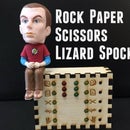Introduction: Poor Man's Arc Reactor Costume
This is a quick Instructable on an Arc Reactor that I made on the cheap and quick for a Halloween party last year. I needed a costume but didn't want to go to great lengths to get a getup together. I needed something that gave me an excuse to make/tinker and would be easy to wear. So I decided to go as casual Tony Stark with a glowing arc reactor that would shine through my shirt.
There are a lot of great Arc Reactor based Instructables on here. This one is different, it was made to be cheap, a one to two hour build and easily conceal under clothing. It is not meant to be an intricate, genuine or exact copy of the actual prop. If you are in a pinch for a quick costume and you are used to soldering or making small electronics projects, you likely already have everything you need.
If you want to take this project up a notch check out my latest version made with NeoPixels and user selectable modes. https://www.instructables.com/id/Programmable-Wearable-Arc-Reactor/
Take a look and enjoy!
Step 1: Gather Your Parts
What you will need:
- White LEDs - In this build I used Clear/White focused through hole LEDs
- Heat shrink tubing - Small diameter
- CR2032 Coin Cell
- Coin cell holder - To fit the CR2032
- Fogged window film
- Black cardstock/construction paper
These are the items I used. You can customize yours in many different ways.
Some considerations:
- Consider using diffused LEDs instead, I think it would give you a better overall result.
- The coin cell and holder can be a different size. Mainly just looking for something that will output 3v.
- You could easily use velum or tissue paper as a diffuser
- Index cards, manila folder, etc could be used instead of cardstock. Just something think that will block the light and maintain its shape.
Step 2: Begin Setting Up the LED Layout
Take your LEDs and lay them out. For my design we will start with 6 LEDs.
Leave the positive side (anode) of the LED straight. The positive side is typically the longer leg on through hole LEDs. Bend the negative side (cathode) of the LED approximately 60 degrees away from the anode. The negative leg of the LED is typically the shorter one.
Place a piece of heat shrink tubing over approximately 2/3 of the anode leg. This will serve as an insulator between anode and cathode.
Begin to stack the LEDs as shown in the second picture. You will eventually have 6 LEDs that make up a hexagon and form the shape for our entire build.
Step 3: Solder the LEDs and Coil Cell Holder
Solder all anodes and cathode in parallel to form the hexagon. As you solder the anodes the heat shrink tubing will partially shrink and help hold itself in place to keep insulation between the two legs and prevent a short.
Now solder the battery holder to the LEDs. You made need to use a small bit of scrap wire to make one of the connections. Positive (+) side to the anodes. Negative (-) side to the cathodes. You should now have a battery holder soldered to six LEDs. If you want to stop here your circuit is essentially done.
I found that the setup needed a little more light so I crammed two more LEDs in the center to finish it out. Same setup here, anodes and cathodes in parallel.
Step 4: Insert Coin Cell and Test
If you insert your coin cell now you should see all the LEDs light up. They should all be relatively the same brightness. If you used clear, focused LEDs you should see quickly why diffused LEDs are likely better. You can see in my pictures that the majority of the light is shining outwards. I have a solution for that later.
If your LED's don't light up then pull the battery. You likely have a short somewhere or have the anode and cathodes swapped. Inspect your circuit and correct the problem.
Step 5: Make the Arc Reactor Enclosure
Now is the part that give the Arc Reactor its shape and look. Attached is the image that I used to create mine.
Firstly, I wanted the slimmest design possible so it could fit under my shirt and when turned off it wouldn't be noticeable. My final product is 3.5" in diameter and 0.400" thin. It is a great size.
My entire enclosure is made out of black cardstock. Something easy to work with but rigid enough to hold its shape. You can use an Exacto or hobby knife to cut it out. If you have a crafty wife like me you can use her paper cutter to save a lot of time and give you a great looking finished product. I used her Silhouette Cameo paper cutter. These things are like a great 2 axis CNC for paper. You can also use them with vinyl to create your own circuit boards!
I have included a picture and attached a PDF of the Silhouette pattern I used. The dimensions are: Circle shapes = 3.5" diameter. Strips = 0.40" x 9.62". Use clear tape to tape the strips to the circumference of the circles and you are almost home free. These two halve will press fit together to be a tight fit that won't come apart while wearing.
Now, if you remember that part about using diffused LEDs versus clear/focused LEDs. I lined the inside of the back cap with aluminum foil to help reflect all light and hopefully output more to get the right effect.
Attachments
Step 6: Cut the Diffuser
I used fogged window film that I had laying around to create mine. I cut two circles using the cap as the template. I stacked them inside the front piece in two layers for better diffusion. This seemed to do the trick.
You could use tissue paper or velum and get a similar effect.
Step 7: Put the Battery in and Put It All Together
I put a small piece of tape over the battery to keep it from shorting on the aluminum foil. Then I taped down the circuit down to keep it centered. I taped the whole thing to my chest with medical tape but you could easily attach it to an elastic strap, hang it from a string around your neck or something else.
See the pictures above. The image of it in my hand is in my garage with daylight pouring in and you can still see it "glow" easily. The next picture is indoors with the lights off and the last indoor with lights on. You can use some tape to cover any light bleeds.
Hope you enjoyed the Instructable. Let me know if you make this easy build or improve on it in any way. Check out my updated version of this made with NeoPixels and user selectable modes (much more involved build).
https://www.instructables.com/id/Programmable-Wearable-Arc-Reactor/

Participated in the
Halloween Props Contest 2015

Participated in the
Halloween Costume Contest 2015

Participated in the
Explore Science Contest














